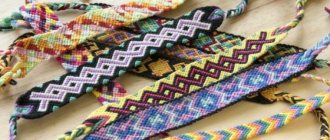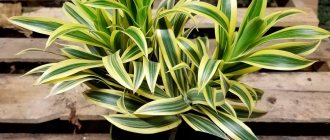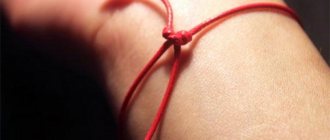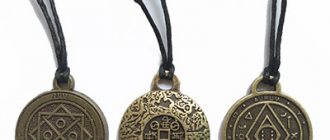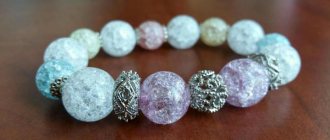Who today remembers where this fashion for everything oriental came from, but the worship of the ancient Chinese teaching of Feng Shui thoroughly conquered the inhabitants of all continents. Everyone especially liked the intricate Chinese weaves. After all, it’s so tempting: you just connect the threads in a certain way - and here you have the fulfillment of all your secret desires. And one of the most popular talismans is the good luck knot .
Classic lucky knot in the shape of a shamrock
In principle, in European countries all Chinese knots are called a knot of luck.
In the East, such nodes are found everywhere
History of appearance
The Chinese knot dates back to Paleolithic times. Knots were tied on the rope, each of which had a meaning, and the importance of the event was determined by size. Later, such knots became decorations for clothing and indoor decor. Until now, each of them has a designation.
Types of Chinese knots
Symbolism of the infinity knot
Looking at it, it is impossible to see either the beginning or the end. The name itself indicates that the main meaning is the manifestation of infinity: this Universe, the existence of all living things in it, knowledge and the path to achieving Enlightenment.
But the meaning of the node is not limited to this. The number of interpretations of its capabilities also suggests infinity. As a symbol of success, it means power over time and over circumstances. Its influence brings good luck to the person who possesses it. Often its energy is favorable for people’s relationships with each other, so it is also perceived as a symbol of endless love.
Another mystical manifestation is the harmonization of space.
According to Feng Shui, it is believed that the node has its greatest influence during the eighth 20-year period. This is exactly the time that is passing now, and it will last until 2024.
Common options
In modern Chinese culture, there are several hundred patterns that have a certain meaning and are a symbol of a certain energy. A few of the most common nodes:
- Swastika, or the pattern of true love and virtue. Outwardly it resembles the symbol of the Buddhist sun and brings prosperity to the home of its owner.
- Good luck. Common Chinese weaving. Most of the patterns in the shops are simply called lucky knots due to their Chinese origin.
- Six petal flower. A symbol of complete well-being.
- Josephine, or money coin. A symbol for those who dream of becoming rich.
- Mystical. In translation, the name of this node means infinity. Those who find it difficult to cope with this pattern try its elongated variation.
Expert opinion
Melnik Dmitry
feng shui master
Before you start weaving your talisman, it is recommended to carefully study the technique so that the work brings pleasure and brings good luck.
Mystical feng shui knot
The mystical knot (also sometimes called magical) represents the infinity of abundance - in money, health, love, and so on. According to the teachings of Feng Shui, the energies that make up our entire world can give a person abundance in everything, and the most important thing is to enter into harmony with these forces.
It is talismans, which include the mystical knot, that can help a person with this. The area of your life it will impact depends on which sector of your home you decide to place it in.
WATCH THE VIDEO
For example, if your main goal today is to improve your material well-being, hang a mystical knot in the wealth sector. You can also tie it to any amulet that you already have, and then the knot will increase its influence.
The Feng Shui magic knot is often used not just as a separate talisman, but also as an addition to jewelry, clothing, and interior items. In this case, it protects its owner from the effects of negative energies. Moreover, the knot can not only be tied, but also drawn or even engraved.
Its main component is the six eights, where the six traditionally symbolizes divine luck, and the eight reflects the current twenty-year period in which we live, which will last until 2024.
Basic rules of weaving
First of all, you need to choose the right threads. Bright and cheerful colors such as red, yellow, green and brown are better. In total, there are 20 basic weaving techniques, on the basis of which all patterns are made. Most knots can be tied with either one or two threads. At the same time, double weaving always looks much more beautiful, emphasizing the individuality of its owner.
A talisman that attracts the required amount of money looks like this:
- A basic knot is created, then the ends at the bottom need to be crossed. Next, we create the pattern first on the left, through the eyelet. We place a new loop under the loop, then bring the end down, where the trunk of your money tree will be.
- Then you need to turn the product over so that the sides change places. After this, repeat all steps.
Each type of weaving is appropriate for a gift. The “double happiness” knot will be a great surprise for a wedding, and the “longevity” weave is best given as a birthday present.
Chinese Feng Shui made macrame popular. Therefore, you should not refuse a talisman in the form of a wicker pattern that will hang at home, or in the form of a personal decoration. And give joy, happiness, positivity, as well as wealth and good luck.
The intricacies and mysticism of Chinese knots
Since ancient times, even before the advent of writing, many peoples have used knots to record information - the so-called knot writing. The ancient Incas used knotted writing (khipu) for calculations - in trade, in governing the country. Among the Indians of North and South America, kipu knots and wampum beads were used as historical and religious “books.” In ancient Babylon, and later among the Slavs, knots were used for magical rituals and witchcraft. In the Kabbalistic tradition, the nodes encode gematric information regarding the name of God or the commandments. In knot writing, information is conveyed both by the shape of the knot and the color of the cord from which it is tied, as well as the order and combination of various knots.
But the art of knot weaving reached its highest peak in China. Just as ordinary letters look boring compared to hieroglyphs, so the knots used in quipus look “just knots” compared to the luxurious Chinese knots. And although the advent of writing led to the abandonment of knotted writing, Chinese knots did not remain purely decorative, but also carry a semantic load.
The art of decorating clothing, weapons, interiors and household items with the help of decorative knots has been known in China since the Tang (618–907) and Song (960–1279) dynasties, and gained popularity during the Ming dynasties (1368–1644). .) and Qing (1644–1911). It was during this period that the art of weaving knots “emerged from the people” and became a handicraft befitting the aristocracy. Knots were not only art, but also a means of communication: they were used to convey wishes and blessings, and express good feelings. And, like any decoration, knots served as amulets against evil forces.
The knots were tied from silk cords, so the oldest examples of decorative knots that have survived to date date back to the end of the 19th century. More ancient decorative knots are known only from images. Thus, images of decorative knots are found on bronze vessels of the Warring States period (475–221 BC), in paintings of the Western Han period (206 BC–220 AD), on Buddhist sculpture from the Northern Dynasties (386–581). And during archaeological excavations, bone tools for tying and untying knots were discovered, approximately age. 100,000 years!
Over many centuries, the art of decorative knots has developed and reached perfection. However, with the fall of the Chinese Empire and the beginning of the Republican era, this art began to decline: first, decorating things with knots disappeared from everyday use, and then from holiday use. The Cultural Revolution finished off the art of decorative knots. However, in Taiwan in the 1970s. There were enthusiasts for the revival of the tradition, among whom Lydia Chen (Chen Hsia-Sheng) is especially noted. They collected images of knots from museums and traveled to villages to learn this art from the latest masters. Thanks to their efforts, the art of decorative knots has been revived and has become accessible to many connoisseurs of traditional applied art.
Most Chinese knots are double-layered, symmetrical, and have two ends going into the knot and two coming out of it. Knots are named either by their shape or by their symbolic meaning. They are woven from silk cords of various colors, but the color red is most often used, as it symbolizes good luck and prosperity. Knots serve as fasteners on clothes, pendants and keychains, and are used in hair decorations, costume jewelry, and interior design.
The symbolic meaning of Chinese knots
The most famous of the Chinese knots is the Pan Chang, or mystical knot. It is tied in such a way that the beginning and end are not visible (however, this applies to many Chinese knots). The mystical (eternal) knot symbolizes unceasing eternal life, limitlessness, endless wisdom and awareness, and compassion. In Feng Shui symbolism, the mystical knot represents the continuous flow of good luck in love, in business, in business, the endless flow of life, and greatly enhances the effect of other positive symbols.
The “Two Coins” knot means prosperity and wealth, and at the same time longevity.
Longevity knot - I think it’s clear. Appropriate as a happy birthday greeting.
Appropriate as a happy birthday greeting.
The “Double Happiness” knot means happiness in marriage. Suitable for wedding congratulations.
Luck knot - too, I think everything is obvious 
The “Wand” knot (Ju I) is reminiscent of the wands of Buddhist missionaries and the scepters of royalty. This is a Taoist symbol of immortality, and the name Ju I means “everything is in accordance with the desires of your heart.”
The Harmony of Ten knot symbolizes everything that, according to Chinese beliefs, constitutes a good life: a lot of return on one investment, two hearts living together in harmony, successful passing of exams, peace and tranquility at any time of the year, a generous harvest, abundant growth of crops, seven successful sons, long life, nine generations under one roof and complete prosperity.
This, of course, is not all the nodes. And now for some beauty 
The magical meaning of the artifact
By combining an attribute with others, a person can become happier.
The talisman represents a continuous and endless process, multiplied many times over. Wearing the knot itself protects against the evil eye, negative energy and everything negative from the outside. When used with other magical artifacts, the amulet increases love, happiness, luck, prosperity, success and health.
Another name is endless knot. Symbolizes karmic consequences, the variability of temporary processes, wisdom, compassion, the cycle of everything in nature, impermanence and the relationship of all living things with the Universe. Used as a symbol of eternal love and happiness. A magical bundle of happiness will help make your cherished dreams come true and add confidence in your abilities.
The artifact is also used as a longevity node. Represents the desire to experience immortality, eternal beauty and youth. Tied to heal and get rid of serious illnesses, as well as to attract physical and mental health, vigor, relieve stress and tension. When combining the knot with other artifacts, its power doubles and acts without restrictions. Whatever the owner of the amulet wishes, he will have such protective power.
What does the luck activator look like?
A knot consisting of eights came to Feng Shui from Buddhism, and is tied in such a way that when examined, it is not known where its beginning and end are. It is made in a variety of colors, both from threads and from any other material, including precious metals in the form of jewelry. The knot is also knitted, embroidered, drawn and engraved. The artifact is complemented by such talismans as a red thread, coins, various stones and beads. Nodules are divided into the following types:
- simple;
- double;
- elongated;
- difficult;
- consisting of several nodules.
Ways to use the mystical knot
The Chinese character is used in different ways:
- Weaved from a cord and worn with a belt;
- Carved out of stone and placed in different zones of space to fulfill a wish and activate the sector;
- Worn around the neck on a cord or thread for good luck, as a talisman;
- They use a keychain and visualize with it, imagining what they want to buy or do in the near future;
- Hang the picture on the wall in a given sector.
In any form, the knot will bring success and good luck to the owner. It even balances out moments of anger in an unusual situation. And the symbol protects drivers on the road. The power of the talisman is multifaceted.
